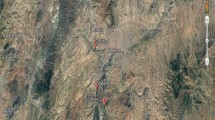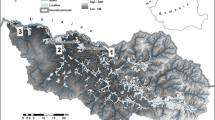Abstract
Surface water samples were collected from mid-Niger Delta, Nigeria, Bayelsa, Delta and Rivers States with high petroleum activities. The impact of these activities on potable water was investigated by determination of polyaromatic and straight chain hydrocarbon contents. The 16 US EPA priority polynuclear aromatic hydrocarbons PAHs, straight chain hydrocarbon (C8–C40), pH, temperature, chloride (Cl−), were determined. Pseudomonas sp, Proteus sp, Bacillus sp, Penicillium sp, Achromobacter sp and Aspergillus sp were also determined. All the parameters were determined using their respective standard methods. Anieze river in Port-Harcourt had six (6) PAHs-Acenaphthene (0.015 mg/l), 1,2-Benzanthracene (0.004 mg/l), Benzo(b) fluoranthene (0.064 mg/l), Benzo(g, h, i) perylene (0.009 mg/l), Dibenzo(a, h) anthracene (0.040 mg/l) and chrysene (0.015 mg/l). Orash river had chrysene (0.017 mg/l) and fluorene (0.109 mg/l). Only Ifie-Kporo river in Delta State had Dibenzo(a, h) anthracene (4.350 mg/l), while none of the water samples from Bayelsa had any of 16 PAHs. Straight chain aliphatic hydrocarbon of the order C8–C14 were not detected in majority of the samples, whereas C15–C40 were detected in most of the samples with highest to lowest concentrations in water samples from Rivers, Delta and Bayelsa States, respectively. Temperatures above 30°C were seen in some water bodies and highest chloride level was seen in Ozubo river (Rivers state) 17,198.00±0.06 mg/l and 15,850.00±0.03 mg/l in dry and rainy seasons respectively. The pH of all the samples are within internationally accepted limits, except Egbo stream (pH 5.53), Olomoro burrow pit stream (pH 5.79) and Ughewhe stream (pH 5.32), all in Delta State; while Orash river (pH 5.22). In view of the negative impact of surface water in the Niger Delta by petroleum activities and its possible public health importance, we recommend water quality monitoring and suggest the possibility of developing a biomarker for determining the age of a particular pollution.
Similar content being viewed by others
References
Abam TKS, Okagbue PI (1997) The cone penetrometer and soil characterization in the deltas. J Min Geol 33(1):15–24
Abrajano TA, Yan B, O’Malley V (2003) High molecular weight petrogenic and pyrogenic hydrocarbons in aquatic environments. In: Sherwood Lollar B (ed) Environmental geochemistry, treatise on geochemistry, vol 9. Elsevier, Amsterdam, pp 475–509
Ademoroti CMA (1996) Standard methods for water and Effluents analysis. Foludex Publishers Ltd, Ibadan
American Public Health Association (1998) Standard methods for the examination of water and wastewater, 20th edn. APHA, AWWWA, WEF, Washington
Anyakora C, Coker H (2006) Determination of polynuclear aromatic hydrocarbons (PAHs) in selected water bodies in the Niger Delta. Africa Biots 5(21):2024–2031
Anyakora CA, Ogbeche KA, Palmer P, Coker H, Ukpo G, Ogah C (2004) A screen for Benzo[a] pyrene carcinogen, in the water samples from the Niger Delta region, Nigeria. J Hosp Med 14:288–293
Awosika LF (1995) Impacts of global climate change and sea level rise on coastal resources and energy development in Nigeria. In: Umolu JC (ed) Global climate change: impact on energy development. DAMTECH Nigeria Limited, Nigeria
Baumard P, Budzinski H, Garrigues P (1998) Polycyclic aromatic hydrocarbons in sediments and mussels of the western Mediterranean Sea. Environ Toxicol Chem 17:765–776
Benlahcen KT, Chaoui A, Budzinski H, Bellocq J, Garrigues PH (1997) Distribution and sources of polycyclic aromatic hydrocarbons in some Mediterranean coastal sediments. Mar Pollut Bull 34(5):298–305
BICNEWS (2005) Bioremediation: Nature’s way to a cleaner environment. Malaysian Biotechnology Information Centre (MABIC) 9:1–6 (www.bic.org.my)
Davidson NC, Laffoley ED, Doody JP, Way JS, Gordon J, Key R, Pienkowski MW, Mitche R II, Duff KL (1991) Nature conservation and estuaries in Great Britain. Joint Nature Conservation Committee, Peterborough
Environment Canada (1993) Priority substances program. CEPA assessment report, chlorinated parafins. Commercial Chemicals Branch, Hull, Quebec
Esrey SA, Potash JB, Roberts L, Shiff C (1991) Effects of improved water supply and sanitation on ascariasis, diarrhea, dracunculiasis, hookworm infection, schistosomiasis and trachoma. Bull World Health Organ 69:609–621
Guillen MD, Sopelana P, Partearroyo MA (2000) Determination of polycyclic aromatic hydrocarbons in commercial liquid flavouring of different compositions by gas chromatography–mass spectrometry. J Agric Food Chem 48:126–131
Kaizer AN, Adaikpoh EO, Osakwe SA, Obanogun-Odiete E (2001) Heavy metal pollution of surface water within coal mining sites around Enugu, Southeastern Nigeria. Agid 1–5
Kennek KY (1996) Inhibition of cell–cell communication by commercial chlorinated paraffins in rat liver epithelial IAR 20 cells. Pharmacol Toxicol 79:23–28
Leahy JG, Colwell RR (1990) Microbial degradation of hydrocarbons in the environment. Microbiol Rev 54:305–315
Mastral AM, Callén MS, López JM, Murillo R, García T, Navarro MV (2003) Critical review on atmospheric PAH. Assessment of reported data in the Mediterranean basin. Fuel Process Technol 80:183–193
Maya E (2006) Inside the militant colony, Saturday Sun Newspaper. (www.sunnewsonline.com) 4–5
Obasi RA, Balogun O (2001) Water quality and environmental impact assessment studies. Afr J Environ Stud 2(2):228–231
Omoti CE (2006) Socio-demographic factors of adult malignant lymphomans in Benin City, Nigeria. Postgrad Med J 13(3):256–260
Omoti CE, Halim NK (2005) Adult lymphomas in Edo State, Niger Delta region of Nigeria—clinicopathological profile of 205 cases. Clin Lab Haematol 27(5):302–306
Ovrawah L, Hymore FK (2001) Quality of water from hand-dug wells Niger-Delta region. Afr J Environ Stud 2(2):166–173
Raoux C, Bayona JM, Miquel JC, Teyssie JL, Fowler SW, Labaiés J (1999) Particulate fluxes of aliphatic and aromatic hydrocarbons in near shore waters to the northwestern Mediterranean Sea, and the effect of continental runoff. Estuar Coast Shelf Sci 48:605–616
Reijers TJA, Petters SW, Nwajide CS (1996) The Niger Delta basin. In selected chapters on geology, sedimentary geology and stratigraphy in Nigeria. SPDC, Nigeria, pp 103–117
Rosenberg E (1993) Microorganisms to combat pollution. Kluwer Academic, Boston
Seleye-Fubara D, Nwosu SO, Yellowe BE (2005) Soft tissue sarcomas in the Niger Delta Region of Nigeria (a referral hospitals study). Niger J Med 14(2):188–194
Stiff MJ, Cartwright NG, RI Crane (1992) Environmental quality standards supply on ascariasis diarrhea, dracunculiasis, hookworm infection, schistosomiasis and trachoma. Bull World Health Organ 69:609–621
Tony GT, Fisk AT, Westmore JB, Muir DCG (1998) Environmental chemistry and Ttxicology of polychlorinated n-alkanes. Rev Environ Contam Toxicol 158:53–128
Wills B, Crookes MJ, Diment J, Dobson SD (1994) Environmental hazard assessment: Chlorinated paraffins. Toxic Substances Division, Dept of the Environment Garston, UK
Author information
Authors and Affiliations
Corresponding author
Rights and permissions
About this article
Cite this article
Nduka, J.K., Orisakwe, O.E. Water Quality Issues in the Niger Delta of Nigeria: Polyaromatic and Straight Chain Hydrocarbons in Some Selected Surface Waters. Water Qual Expo Health 2, 65–74 (2010). https://doi.org/10.1007/s12403-010-0024-5
Received:
Revised:
Accepted:
Published:
Issue Date:
DOI: https://doi.org/10.1007/s12403-010-0024-5




